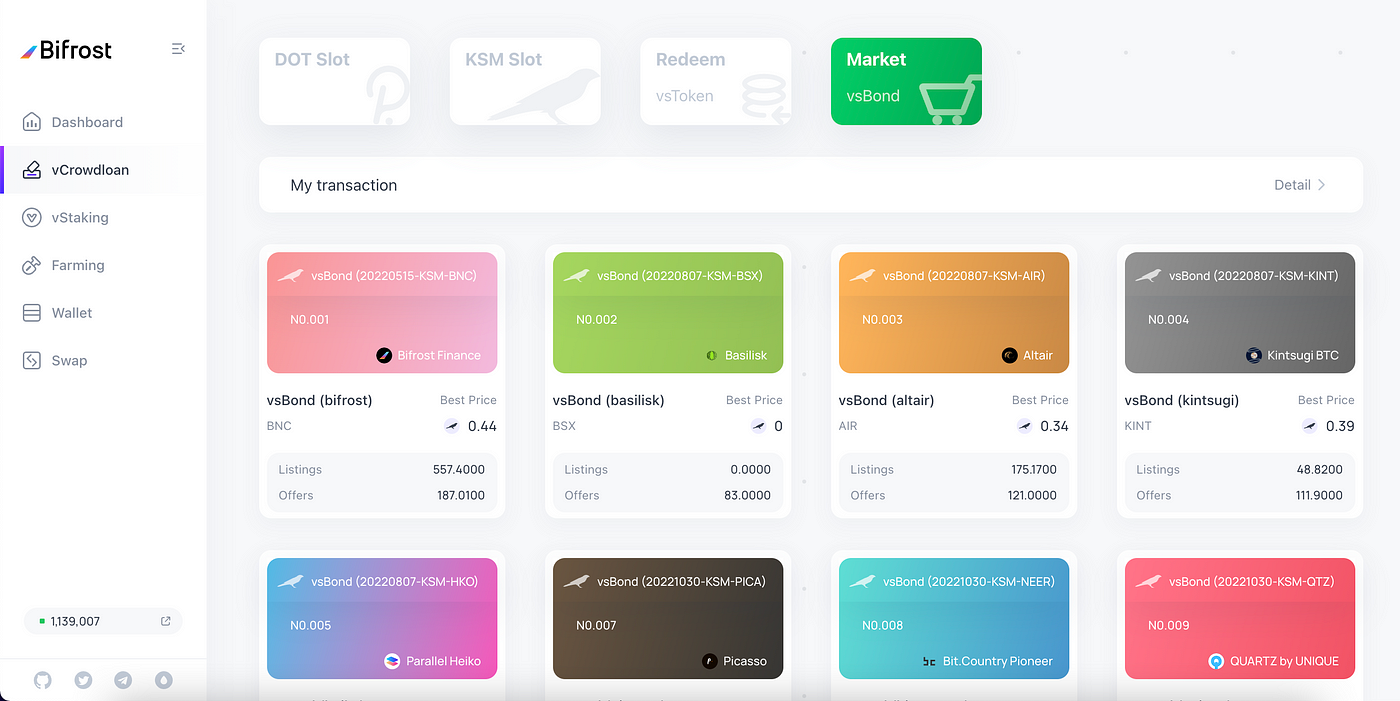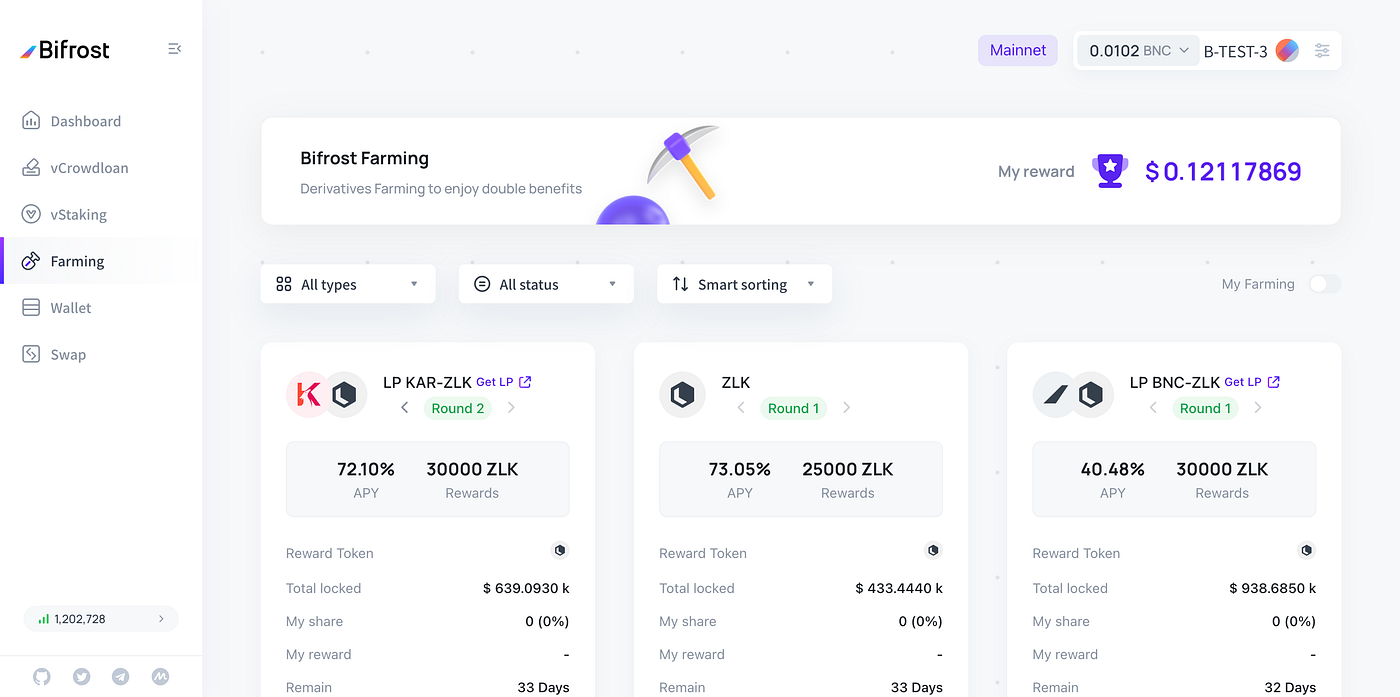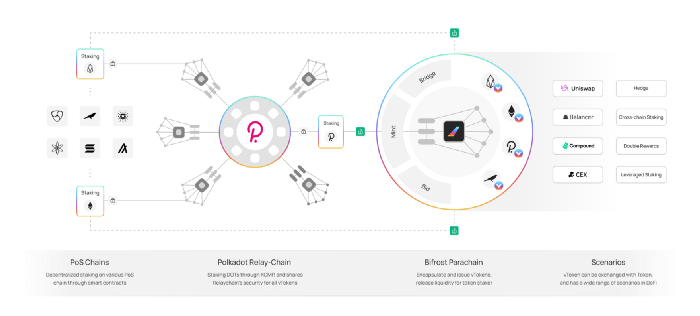Q&A to understand the usage and price attributes of vsBond
As slot auction derivatives protocol developed by Bifrost, SALP has gone through several rounds of lending practice and achieved good results. Bifrost actively popularized science and introduced SALP through articles, AMAs, meetup activities, and other forms, constantly enabling community partners to understand SALP deeply, participate in trading derivatives, and enjoy the benefits of liquidity release.
Many friends have fully understood vsKSM/vsDOT after reading SALP-related articles. With the official launch of the vsBond trading market, they are still confused about vsBond. This article intends to straighten out and help you understand vsBond and its origin, utility, price attribute, and other characteristics.
How does SALP release Crowdloan liquidity?
We have understood that Polkadot is a fragmented multi-chain system composed of a relay chain and parachain (including a bridged heterogeneous chain). The parachains communicate reliably through the relay chain. However, due to the performance of the relay chain, the accessible parachain is limited. Polkadot created the form of slot auction, allowing candidate projects to compete for parachain slots in the form of crowdloan stake DOT / KSM. To release the liquidity of staked DOT, Bifrost developed the SALP protocol. Users who participate in crowdloan staking through SALP will obtain liquidity derivatives.
Since the lease expiration dates of different parachain auctions are different, SALP has to generate different derivatives for parachain auctions, but this cannot maximize the effect of releasing liquidity. Therefore, we adopt the “decoupling scheme” to create two different types of derivative assets, vsToken, and vsBond. vsToken (vsDOT / vsKSM) is used to express homogeneity and vsBond is used to express heterogeneity. Users who participate in crowdloan pledges through SALP will obtain vsDOT/ vsKSM and vsBond derivative assets simultaneously.
Why is vsBond needed?
The decoupling method increases the complexity on the surface but releases the liquidity to the greatest extent. Suppose only one derivative is designed, with only vsDOT / vsKSM and no vsBond. In that case, the heterogeneity must be borne by vsDOT / vsKSM, which means that supporting different parachains will generate different vsDOT / vsKSM (e.g., vsDOT-Parachain X, vsDOT-Parachan Y). vsDOT/vsKSM cannot be used as a complete homogenization token to form the maximum liquidity.
Is vsBond NFT?
vsBond is not NFT, but vsBond is not the fungible pass as vsDOT/vsKSM. We will call it a “semi fungible pass”. A specified vsBond is a fungible token: vsBond (20220515-KSM-BNC), and vsBond is the total of multiple specified vsBonds, which is the sum of a class of fungible tokens.
What is the complete expression of vsBond?
The vsDOT/vsKSM obtained by participating in different parachain auctions are the same, but the vsBonds are different. We need a way to represent different vsBonds. We will fully represent vsBond in this way:
vsBond (Expiration date DOT / KSM parachain name)
DOT / KSM indicates whether the parachain is a Polkadot relay chain or a parachain of Kusama relay chain.
We need to know that the fundamental reason for the different vsBonds corresponding to different parachains is the cashing period, which has little to do with parachain. vsBond (20220808-DOT-Parachain A) and vsBond (20220808 -DOT-Parachain B) are completely equivalent. At the same time, according to Polkadot auction rules, there is no parachain with the same lease expiration date.
It means that for the complete representation of vsBond, the parachain information can be omitted and expressed as
vsBond (Expiration period — DOT / KSM)
Nevertheless, another simple way cannot be adopted:
vsBond (DOT / KSM parachain name) ❎
As long as the same parachain may often participate in the bidding, there are created vsBonds with different payment periods.
In the relevant pages of Bifrost DAPP, to present more intuitively, we will adopt a complete expression.
What can vsBond do?
1. Portfolio redemption
During and after the cashing period, vsBond can cooperate with vsDOT / vsKSM to redeem DOT / KSM. Redemption utility is the essential utility of vsBond, and it is also the basis and support for the existence of other utilities.
2. Independent trading and portfolio trading
Although vsBond is not directly convertible in DEX like vsDOT / vsKSM, it can also be traded at any time. Bifrost has created a unique market for vsBond, and the holder can trade vsBond alone or in combination with the same amount of vsDOT / vsKSM.
At present, Bifrost DAPP has launched the separate trading market of vsBond, and the combined trading market will be launched soon.

Screenshot of vsBond Market
3. Farming
If you want to hold vsBond for a long time and don’t want to sell it, we also offer a way to lock up your vsBond. vsBond can be combined with vsDOT/vsKSM to participate in SALP mining and lock up your vsDOT/vsKSM+vsBond to split the reward pool provided by Bifrost and the parachain project partners.

Screenshot of Bifrost.app
Will vsBond expire?
vsBond does not have the problem of expiration. It will always be valid. Each vsBond has a corresponding lease expiration date called the cashing period. It cannot be redeemed before the expiration period, but you can use it to redeem with vsDOT / vsKSM at any time on and after the expiration period. If you like, you can always hold it, and it will always be valid.
Can you still get rewards from the project after selling vsBond?
vsBond is not linked to the rewards of the project party. The project side will only reward users who directly participate in crowdloan, which means that if you participate in crowdloan, you can get the crowdloan reward of the project side even if you sell vsBond. If you buy vsBond but do not participate in crowdloan, you cannot get the crowdloan reward of the project party.
How to understand the price attribute of vsBond?
We can start with the price attribute of vsDOT / KSM + vsBond because we can understand it in the futures framework. The so-called futures refers to the assets that can be cashed in the future. (Which is much easier for you to understand in English.)
vsDOT+vsBond (20220808-DOT) refers to the DOT that can be cashed after August 8, 2022. It is a typical DOT future. The English expression will be more intuitive — future DOT! The price attribute of futures is closer and closer to the spot price as the maturity date approaches. The price of future DOT should be the price of DOT multiplied by a specific discount rate.
Bifrost once envisaged providing a function that supports the synthesis of vsDOT / vsKSM and vsBond into a new derivative fDOT / fKSM (where f is the abbreviation of future), but adding another derivative will further increase the complexity, so the function was finally abandoned. We provide a portfolio on a trading market. You can combine the two derivatives and trade them as one derivative. This combined trading market can be fully understood as DOT / KSM futures market.
Next, we can understand the price attributes of vsDOT / vsKSM and vsBond. Assuming that vsBond has reached the payment period, the price of vsDOT+vsBond(y/m/d-DOT) should be completely equal to the price of DOT. In theory, the price of vsDOT is 0.5 DOT, while the price of vsBond(y/m/d-DOT) is also 0.5 dot. If vsBond fails to reach the cashing period, then vsDOT+vsBond(y/m/d-DOT) < 1 DOT. We assume that the discount is 80%, and the sum of the two prices is 0.8 DOT. Since vsBond bears the cashing period attribute, in the theoretical state, the price of vsDOT is still 0.5 DOT, while the price of vsBond(y/m/d-DOT) is 0.3 dot. Of course, many factors affect the price. Both vsDOT/vsKSM and vsBond will fluctuate around the reasonable value.
If someone hoards one of vsKSM/vsDOT and vsBond, will the other be unable to redeem for a long time and depreciate?
It is a typical concern about the SALP double derivatives scheme. There is no need to worry about this problem because slot bidding is a regular and continuous process, and new vsKSM/vsDOT and vsBond will continue to be produced. Hoarding is unprofitable and makes hoarders lose the opportunity cost of their funds.
Why did Bifrost’s vsBond market adopt the form of order book instead of DEX?
As mentioned above, vsBond does not refer to a single pass but the sum of a class of passes. It means that there are many categories of vsBond. If Bifrost establishes its liquidity in DEX, it will need to develop many transaction pairs. However, if a third party has established liquidity in DEX, you can also trade. Still, the upper limit of liquidity is the casting volume of a specific vsBond, and its depth is likely to be insufficient, which may lead to a large transaction slip point.
The vsBond individual trading market and portfolio trading market provided by Bifrost are more general and appropriate vsBond trading channels. You can pay the bill or sell the bill according to your intention. Of course, the disadvantage of thin orders is that you have to wait for no suitable opponent order.
Summary
The design of the two derivatives of SALP is the best choice after weighing the advantages and disadvantages. If heterogeneity is inevitable, we will limit it to vsBond to fully release the liquidity of vsKSM/vsDOT. In this way, at least half of the value can be cashed immediately.
Through combined trading or combined farming, the two derivatives can also achieve the effect of one derivative, while one derivative can not achieve the liquidity brought by the two derivatives. Fundamentally speaking, SALP’s dual derivative scheme provides more options than the single derivative scheme.
What Bifrost?
Bifrost is the Polkadot Ecological DeFi basic protocol. It is committed to becoming an infrastructure for pledged assets to provide liquidity. Bifrost launched derivatives vToken for Staking and Polkadot Parachain Slot (Crowdloan). It has obtained $2.15M in fund-raising from NGC, SNZ, DFG, CMS and other institutions and Web3 Foundation Grant. It is also a member of Substrate Builder’s Program and Web3.0 Bootcamp.

vToken can optimize transactions in multiple scenarios such as DeFi, DApp, DEX, CEX, and realize the transfer channel of pledge rights such as staking and crowdloan through vToken, realize the risk hedging of pledge assets, and expand scenarios such as vToken as collateral for lending, its staking reward part of the interest can be offset to achieve low-interest loans.
Learn more about Bifrost
Website | Forum | Telegram | Medium | Twitter | Discord | SubSocial | GitHub